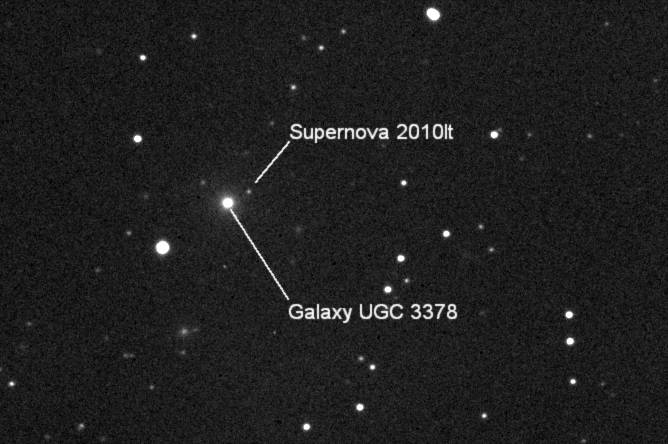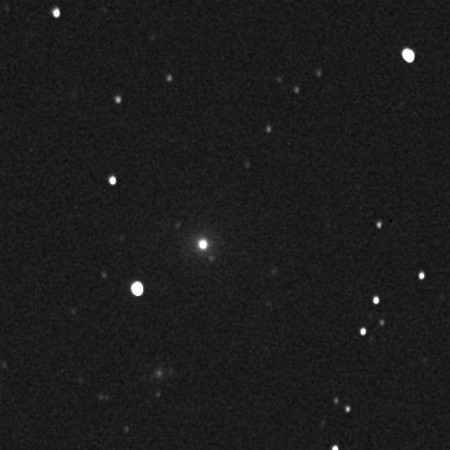Images and discovery details of Supernovae SN2010lt in UGC 3378
(imaged on December 31, 2010 and discovered on January 2, 2011 and confirmed on IAU Electronic Telegram 2618)
Discovery made by Kathryn Aurora Gray (age 10!), Paul Gray and Dave Lane from Abbey Ridge Observatory
Read some of the many news stories about it from around the world!
Visit the supernova's Wikipedia page that someone created! There is also a dedicated page on 2010lt at David Bishop's Bright Supernovae site.
Contacts
- Dave Lane - dave at davelane dot ca
- Paul Gray - snpgray at gmail dot com
Discovery Notes
Kathryn Aurora Gray, Paul Gray, and I are pleased to report that we have discovered a supernova (mag ~17) in UGC 3378 (a magnitude 15 galaxy in the constellation of Camelopardalis), as reported on IAU Electronic Telegram 2618 (see below).
It was imaged in early evening on New Year's Eve in 2010 and discovered on January 2, 2011 by Kathryn Aurora Gray (age 10) and Paul Gray (located in Birdton, NB).
It was verified shortly after dark later that day by Illinois-based amateur astronomer Brian Tieman and Arizona-based Canadian amateur astronomer Jack Newton. It was then reported to the IAU's Central Bureau for Astronomical Telegrams.
This is the third discovery from the Abbey Ridge Observatory, my fourth, Paul's seventh and Kathryn's first! So far was we know, Kathryn's discovery at age 10 made her the youngest supernova discoverer at the time, but in October 2013 her younger brother Nathan beat her record by 33 days!
Discovery Image

Before/After Animation:

Details
Designation: Supernova 2010lt
Discovered at 2010/12/31.921 by Kathryn Gray, Paul Gray and Dave Lane
Position: 6h06m09s.18, +83o50'28".8
Located 20" west and 10" north of the center of UGC 3378
Brightness: ~17 magnitude
Type: Ia (sub-luminous) (a recent paper in Nature suggests that the explosion is due to two White Dwarf stars merging)
Galaxy Names: PGC18399, UGC 3378, MCG14-3-17, CGCG362-13
Galaxy Position: 06:06:20.8, +83°50'19"
Galaxy Helio. radial velocity: 5521 km/s
Galaxy Approx. Distance: 240 million ly
Galaxy Size (arcmin): 1.6'
Galaxy Magnitude: 15.0
Extract from IAU Electronic Telegram # 2618
Electronic Telegram No. 2618
Central Bureau for Astronomical Telegrams
INTERNATIONAL ASTRONOMICAL UNION
CBAT Director: Daniel W. E. Green; Hoffman Lab 209; Harvard University;
20 Oxford St.; Cambridge, MA 02138; U.S.A.
e-mail: cbatiau@eps.harvard.edu (alternate cbat@iau.org)
URL http://www.cbat.eps.harvard.edu/index.html
Prepared using the Tamkin Foundation Computer Network
SUPERNOVA 2010lt IN UGC 3378
David J. Lane, Stillwater Lake, NS, Canada; and K. A. Gray and Paul Gray, Birdton, NB, Canada, report their discovery of an apparent supernova (mag about 17.0) on an unfiltered CCD image taken with a 0.36-m f/5.5 telescope on 2010 Dec. 31.921 UT, with a confirming image taken by Brian Tieman (Streator, IL, U.S.A.) showing the new object at mag about 17 on 2011 Jan. 2.990. The new object is located at R.A. = 6h06m09s.18, Decl. = +83o50'28".8 (equinox 2000.0), which is about 20" west and 10" north of the nucleus of the galaxy UGC 3378. Nothing is visible at this position on unfiltered CCD images taken by Lane with a 0.28-m C11 telescope (+ ST9 camera) on 2005 Oct. 31 (limiting mag approximately 18.0), 2006 Jan. 5 (limiting mag approximately 18.3), and 2006 Mar. 29 (limiting mag approximately 18.5); also, nothing is visible at the position of 2010lt on digitized Palomar Sky Survey red, infrared, and blue images. Lane has posted an images of 2010lt by himself at http://www.davelane.ca/aro/suspect/ugc3378.jpg.
Extract from IAU Electronic Telegram # 2621
SUPERNOVA 2010lt IN UGC 3378
G. H. Marion and P. Challis, Harvard-Smithsonian Center for Astrophysics (CfA), on behalf of the CfA Supernova Group, report that a spectrum (range 340-740 nm) was obtained of 2010lt (cf. CBET 2618) on Jan. 3 UT by P. Berlind with the F. L. Whipple Observatory 1.5-m telescope (+ FAST). Cross-correlation with a library of supernova spectra using the "Supernova Identification" code (SNID; Blondin and Tonry 2007, Ap.J. 666, 1024) shows that the object is a sub-luminous (1991bg-like) type-Ia supernovae near maximum light.
Last Updated: October 31, 2013.
